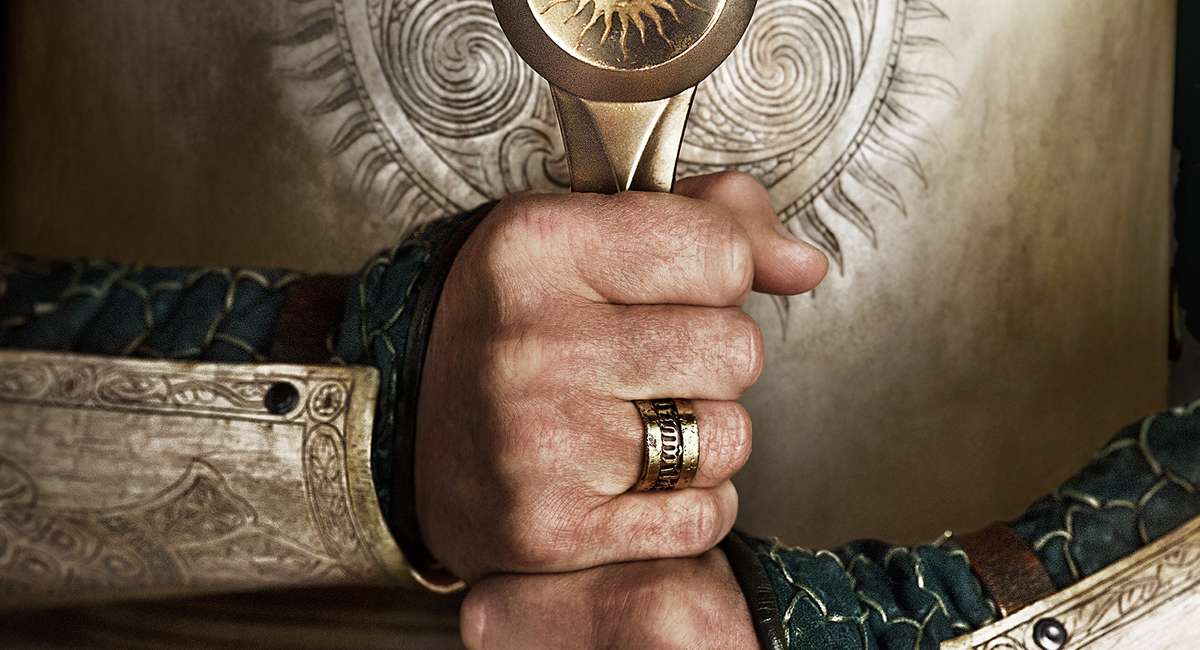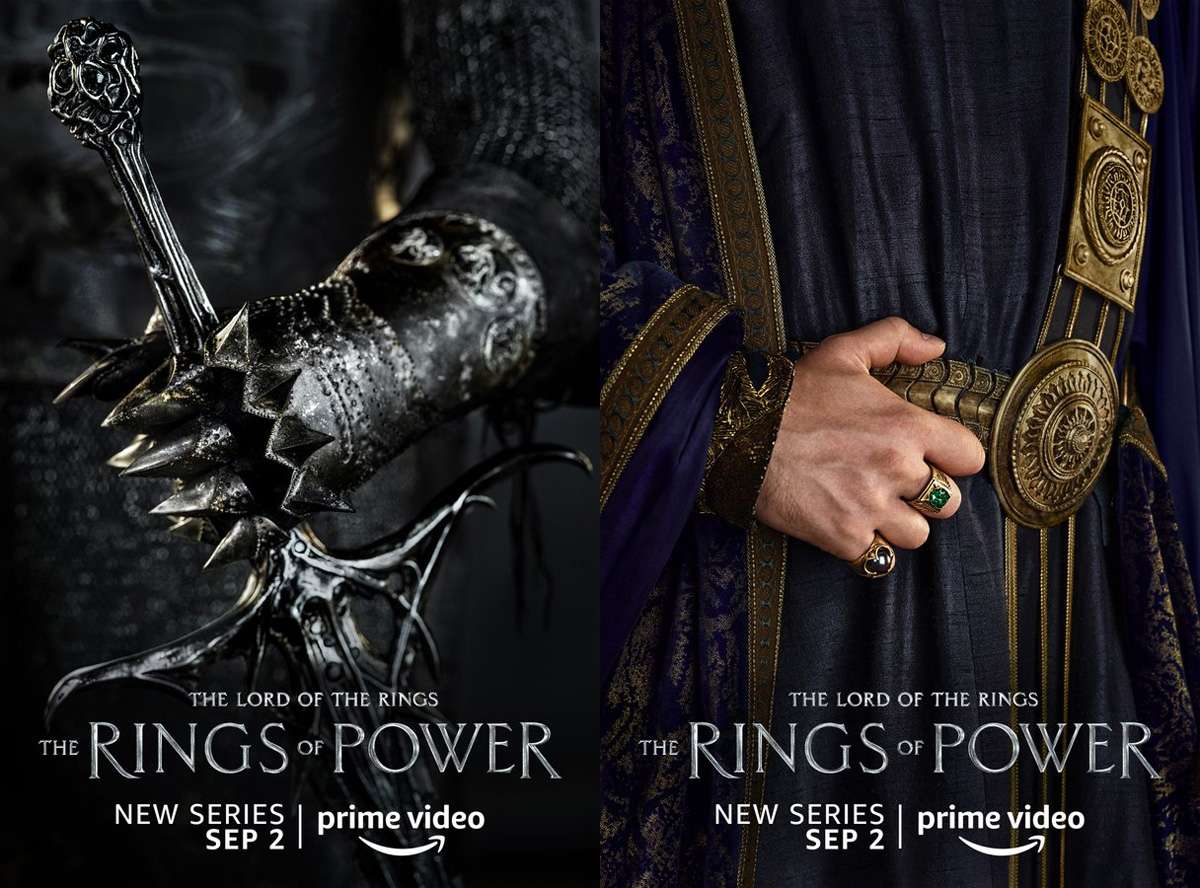
A few weeks after The Lord of the Rings: The Rings of Power revealed its bling-bedecked title with a conceptual teaser clip, the series surprisingly followed up on the nomenclature milestone with first glimpses of the actual characters who will inhabit the show’s small screen Middle-earth. However, Amazon Prime Video opted to officially unleash portrait posters from the exorbitant, long-gestating television series, sans names or faces, inviting wild speculation. While the posters hint at an expansion of J.R.R. Tolkien’s elaborate literary mythology—rendering some guesses impossible—there are still some things one could arguably discern.
Any speculation about The Rings of Power must adhere to the long-confirmed context that it takes place in Middle-earth during the Second Age, a period of time on the planet Arda that spanned 3,441 consequential years for the continent in question, which obviously still invites mystery over its time setting. The era came to an end after an iconic battle—famously depicted in The Fellowship of the Rings’ prologue—during which the Last Alliance of Elves and Men achieved an epochal victory after Gondor’s Prince Isildur cut the One Ring from the finger of Sauron; an act that dealt the Dark Lord and his massive Mordor army a crippling defeat that would last multiple millennia. Of course, this series predates that climactic event, and it has already been hinted that Sauron will be a character on the series, which makes him a prime candidate for one of the new portraits, although not in the form one might expect.

The above image on the left shows a figure in dark, spiky, generally menacing armor holding an evil-looking sword. While one might reflexively size this up as Sauron (which it might very well be), it’s also important to remember that the show chronicles the era in which the titular Rings of Power were still being utilized, presumably before it was known that Sauron created the One Ring to control the trinkets. Thus, the Lord of Mordor will likely appear as Annatar, the “Lord of Gifts,” his far-friendlier-looking alter ego, which he used to inveigle Middle-earth’s respective regional leaders to create the Rings initially.
Interestingly, the image of the robed male figure on the right better aligns with the description of Annatar/Sauron, making the image a potential preview for the show’s version of Tolkien’s big bad. As for the left image, a better guess might be one of the Nazgûl—specifically one of the kings of Men individually gifted one of the nine Rings of Power, who—through enslavement to Sauron and the One Ring—would eventually become the Nazgûl (Ringwraiths). In fact, it might even be the group’s leader, the Witch King of Angmar. Also, given the non-Middle-earth diversity depicted among the posters, there could be more future Nazgûl here, notably Khamûl, the Easterling king, who even briefly became their leader after the Witch King was killed by Éowyn during Return of the King‘s Battle of the Pelennor Fields.
Check out all 23 of the mystery character portraits as collected in a single image just below.

More random observations:
- We can safely assume that one of the female characters on the posters depicts a well-known figure in Galadriel, the luminescent lady of Lothlórien, and an ancient, magic-wielding high elf, who is, at press time, the only character reportedly identified amongst the show’s sizable ensemble. Swedish actress Morfydd Clark (Saint Maud) fills the role made famous by Cate Blanchett on the big screen trilogies of The Lord of the Rings and The Hobbit. However, with none of the posters revealing anything that specifically identifies Galadriel, the reveal could be hidden under the guise of a fashion choice not typically associated with the character.
- Celebrimbor, an elven smith and descendant of royal Ñoldor lineage, seems a likely candidate for the series, making him a possibility among this poster group. He was famously deceived into helping a disguised Sauron forge the Rings of Power. Similarly, Gil-galad, one of the highest-ranking elves in the land, might be here. The character was seen in the Fellowship prologue, played there by Mark Ferguson, fighting in the Battle of the Last Alliance. Likewise, another high elf from the films who was already around during this period, Elrond—famously played across The Lord of the Rings Trilogy by Hugo Weaving—is possibly among this set, specifically as a new version played by one of the show’s cast members, akin to the Galadriel recasting.
- One poster depicts an ornately dressed dwarf character, as revealed by an indicative beard and weapon that’s either an axe or hammer, with a notable focus on his rings, which adorn a pair of hands covered in gold dust. Pertinently, the race of Dwarves was gifted seven Rings of Power, although the ones depicted in the Fellowship prologue appeared bejeweled, which is not what we’re seeing here. Yet, if this is a leader, then he could be Durin III, who directly received the Rings of Power from Celebrimbor. He and the rest of clan Durin’s Folk lived in Khazad-dûm, a vast kingdom beneath the Misty Mountains, which they mined in perpetual pursuit of gold. Of course, Gandalf-delivered exposition in Fellowship revealed how those glory days would eventually end by the middle of the Third Age after their wanton mining awoke the slumbering Balrog, forcing them to abandon the ancestral home, which was henceforth called Moria. However, the Second Age setting of the series will see the clan during a time of prosperity, enjoying an alliance with Celebrimbor and the elves Ñoldor.
- There is a human male who seems to belong to a group that will eventually become Middle-earth’s equestrian-specialized northern kingdom of Rohan, as discerned by a sword pommel decorated with the image of a horse. However, the Rohan we know from the films had yet to exist in the Second Age, during which the region was known as Calenardhon. Pertinently, Amazon’s earliest teaser material for the series manifested in the form of Second-Age-era Middle-earth maps, with one conspicuously focused on Calenardhon. Regardless, it does seem that we’re getting a peek at an early stage of the eventual royal Rohirrim lineage that will eventually lead to King Théoden during the War of the Ring.
- The lost island kingdom of Númenor, which still existed during this era, as filled with the race of long-lived men who would create the kingdom of Gondor—from which Aragorn is descended—will be represented on the series. Notably, one character arguably resembles the majesty of Aragorn’s Return of the King royal coronation attire. In this case, he’s decked out in what appears to be sun-insignia-decorated royal armor, holding a golden sword with a rounded sun-shaped pommel. This could be Númenor’s King Ar-Pharazôn, who, via the insidious influence of a captured Sauron, would ultimately lead his kingdom to ruin in a vain attempt to attain immortality by invading the undying lands of Valinor. The ill-advised act led to devastating retribution (which reshaped a once-flat world into being round,) that destroyed the royal fleet and sunk the island kingdom to the bottom of the sea.
- Tom Bombadil, a never-adapted presence from The Fellowship of the Ring novel whose legend has only grown from not being included in the films, is also widely believed to be making a belated live-action debut on the series. In the book, Tom appears as a hermit in the Old Forest who sings a variety of jaunty songs (to the point of awkwardness for a novel), but he’s actually an ancient being who has roamed Middle-earth since time immemorial and wields a mystical connection to the trees. Consequently, Frodo used Tom’s help to rescue Merry and Pippin from the clutches of the ancient sentient tree known as Old Man Willow; a scenario that was actually shot for the 2001 film, sans Tom’s presence, only to end up cut from the theatrical release. However, fans have long-expected Tom to show his face here, making the ageless character a prime candidate for one of the posters, potentially the white-bearded, wool-sporting figure holding an apple.
- Lastly, one poster shows a figure holding what appears to be the business end of a wizard’s staff. If this is a wizard (perhaps one of the hitherto-unseen blue wizards), then the inclusion would be anachronistic to Tolkien’s Second Age chronicles since the five wizards, Gandalf, Saruman, Radagast and blue wizards Alatar and Pallando (all of whom were originally celestial beings sent to Middle-earth in the form of wise old men), did not arrive until the Third Age, during which they were specifically tasked to prevent Sauron’s resurgence and rise back to power. However, showrunners J.D. Payne and Patrick McKay might be planning some canonical curve-balls that could still allow the series to hit nostalgic high points (namely with wizards,) not traditionally from its setting’s era.
The Lord of the Rings: The Rings of Power is set to debut on Amazon Prime Video on Friday, September 2.

